
Visitor Use Study Reveals Insights into Adirondack High Peaks Wilderness Complex
By Jackie Bowen - Director of Conservation
Monday, July 3, 2023
The Adirondack Council recently announced the release of the visitor use study we commissioned in early 2021 that looks at visitation and recreation patterns in specific areas of the High Peaks Wilderness Complex. This project has been years in the making and now, we get to share it with you all.
This report outlines data collection and analysis of visitor use numbers with the intent to inform management actions. The study was conducted by Otak, a research, planning, and design firm with extensive Visitor Use Management (VUM) experience. This study pre-dates and is separate from the Department of Environmental Conservation’s (DEC) contract with Otak that is carrying out the state’s first VUM process. This early visitor use study is intended to be complementary to the current DEC/Otak partnership and provides a deeper understanding of current conditions and a more robust suite of data for managers to utilize.
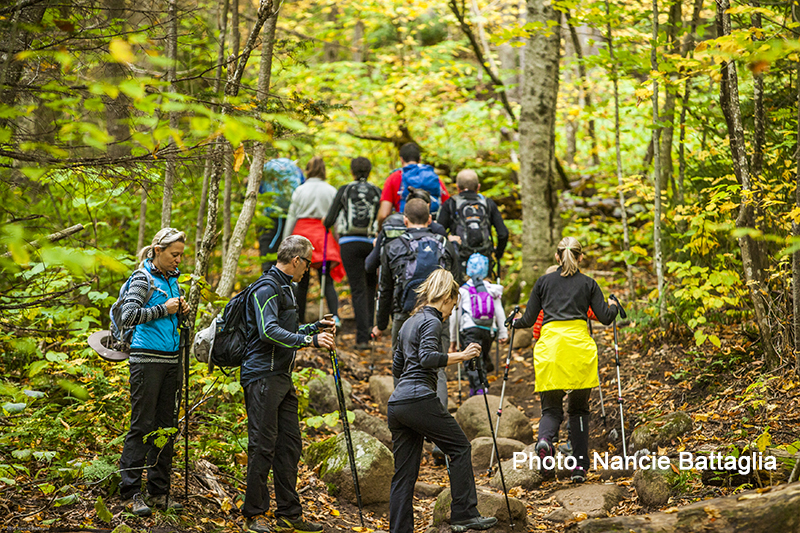 By the end of this blog post, which is admittedly data-heavy and technical, I hope you will walk away with a deeper understanding of what data-driven recreation management could look like (and is headed towards) for Adirondack Forest Preserve lands.
By the end of this blog post, which is admittedly data-heavy and technical, I hope you will walk away with a deeper understanding of what data-driven recreation management could look like (and is headed towards) for Adirondack Forest Preserve lands.
Visitor Use Management
VUM is the latest iteration of management to protect natural resources and enhance visitor experience on public lands. It is based on the federal inter-agency guidance for sustainable recreation called the Visitor Use Management Framework (VUMF). In the simplest terms, the VUM (and VUMF) process requires that management decisions are science-based and data-driven to inform adaptive management actions. This planning framework is intended to review current conditions, define desired conditions, develop and implement a monitoring strategy, and use data to inform appropriate management actions that fulfill the desired conditions through time.
A Quick Recap of Prior Efforts
Overuse, high use, visitor use are terms that have been swirling around the Adirondack news circuit for the last five-plus years now, tracking the several important advancements that have been made by stakeholders in the region. These efforts have included placing front-country stewards at locations in Keene, developing a permit reservation system at the Adirondack Mountain Reserve, releasing the High Peaks Advisory Group’s (HPAG) report in 2021, and appointment of an Adirondack Coordinator.
.jpg) Another big advancement came earlier this year when the Department of Environmental Conservation (DEC) announced that they had contracted a third-party expert to implement a data-driven visitor use management (VUM) planning process in two Forest Preserve regions experiencing high use: the High Peaks Wilderness Complex and Kaaterskill Clove of the Catskills. This effort is distinct and separate from the Council’s visitor use study.
Another big advancement came earlier this year when the Department of Environmental Conservation (DEC) announced that they had contracted a third-party expert to implement a data-driven visitor use management (VUM) planning process in two Forest Preserve regions experiencing high use: the High Peaks Wilderness Complex and Kaaterskill Clove of the Catskills. This effort is distinct and separate from the Council’s visitor use study.
Here's some history:
- 2019: The High Peaks Advisory Group was convened to develop recommendations to address high use in the High Peaks region. HPAG was comprised of state appointed stakeholders, ranging from local businesses to local government to wilderness experts, including Rocci Aguirre of the Adirondack Council.
- 2021: HPAG produced a final report providing a list of recommendations to the state. Among the many recommendations, the report called for “the use of adaptive management and the adoption of the National Parks Service’s Visitor Use Management Framework (VUMF) as the guiding tool”.
- 2022: DEC received $600,000 (to be used over two years) to hire a third-party national expert to conduct VUM studies in 2023.
- 2023: DEC awarded the contract to Otak, a national firm that engages in many research areas, including visitor use and management studies. Their projects have ranged from a transportation and visitor capacities study in Acadia National Park and visitor use site management plan at Lake Roosevelt National Recreation Area to a visitor survey in Zion National Park. The two project leads are Dr. Steve Lawson and Dr. Abbie Larkin.
DEC and Otak held the first of two public meetings introducing the project and soliciting public input earlier this year - one in Saranac Lake and one in Hunter in the Catskills.
Otak’s First Adirondack Visitor Use Management Study
In 2021, the Adirondack Council had begun working with Otak to develop a visitor use study in a subarea of the High Peaks Wilderness Complex. The Council specifically sought out Otak, believing it was important to bring their national experience to the Adirondacks.
That same year, the Adirondack Park Agency (APA) and DEC released its Visitor Use Management & Wildlands Monitoring (VUMWM) framework. While the VUMWM is similar in nature to the federal framework, it is intended to focus on smaller-scale, management specific issues – such as a trail corridor or primitive tent-sites. Both frameworks are currently being used in the Adirondacks. The visitor use study Otak conducted for the Council used some VUMWM indicators to assess visitor use levels in the High Peaks Wilderness Complex.
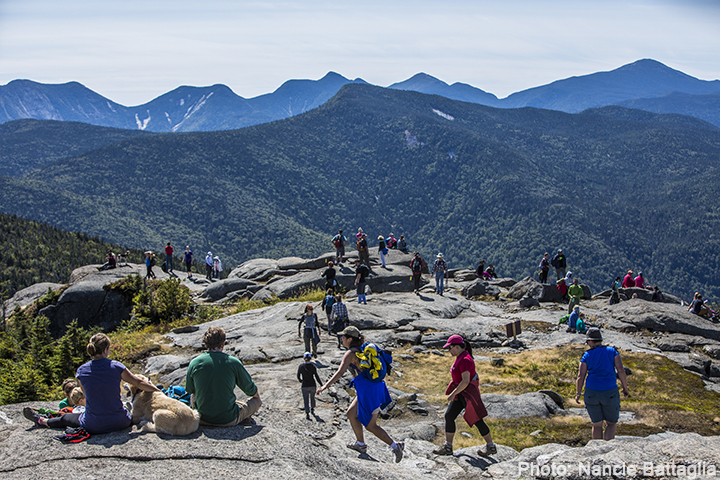 Overview of the Study
Overview of the Study
Purpose:
The purpose of the study was “to provide an initial rationale and important descriptive information on indicators of visitor use for a subarea of the High Peaks Wilderness region to inform and support long-term VUM strategies.”
Study Elements
- Study area was comprised by a subarea of the High Peaks Wilderness Complex (HPWC), about 4% of the HPWC (see image below)
- Data was predominantly collected Fridays through Sundays in July and August of 2021
- Below are the four different study methods used and their locations:
- Roadside parking car counts on Loj Road and South Meadows Road
- Visitor use counts using bi-directional trail counters that counted people moving up and down select trail corridors. These included four primary trailhead access points for Algonquin and Marcy (Adirondak Loj, South Meadows, The Garden and Upper Works) and then three interior trail junctions approaching the summits.
- Encounters on trails counted the number of group-to-group interactions seen on select trail corridors (Algonquin trail toward Algonquin Summit and Van Hoevenberg trail toward Marcy Summit). This was meant to assess the typical visitor experience.
- People-at-one-time (PAOT) counts were done on select high-elevation alpine summits, Algonquin and Marcy, to approximate the number people on the summit.
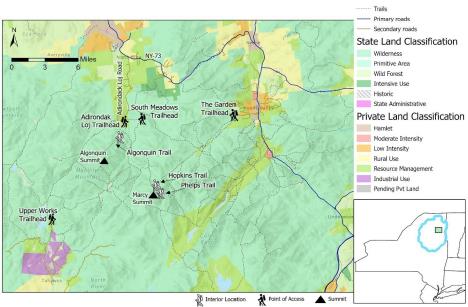 I could spend a lot of time digging into the study methods, but I encourage you to go and take a look at the report yourself. It underscores the scientific rigor Dr. Lawson and Dr. Larkin of Otak used in this study.
I could spend a lot of time digging into the study methods, but I encourage you to go and take a look at the report yourself. It underscores the scientific rigor Dr. Lawson and Dr. Larkin of Otak used in this study.
Findings from the 2021 High Peaks Wilderness Complex VUM Study
Now we are to the part you really want to know about – the results of the study. Well, here are a few highlights:
Daily Visitor Levels
- Daily visitor levels originated mostly out of the Adirondak Loj
- Saturdays saw the highest numbers of visitors
- Average of about ~260 visitors arrived per day at the Loj (with the Saturdays often seeing more than 600 people)
- At the Loj, hourly arrivals started around 4:00am and peaked between 6:00 and 8:00 am
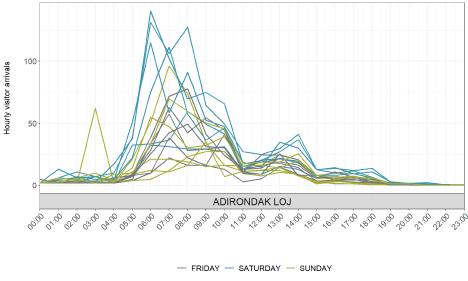 Hiking Encounters on Trails
Hiking Encounters on Trails
- The average group size was 2 people
- Based on the average intergroup encounter, visitors could encounter as many as 32 other groups in a 4-hour span on the Algonquin trail corridor, and as many as 40 for the Van Hoevenberg trail corridor
- In terms of solitude, group encounters averaged occurrences every 7 minutes on the Algonquin trail while the Van Hoevenberg trail was every 6 minutes
PAOT Counts
- Mount Marcy experienced urban walk-way-level crowding
- At the Adirondak Loj trailhead, when there are 300+ daily visitors, the Loj parking lot is likely to be at capacity
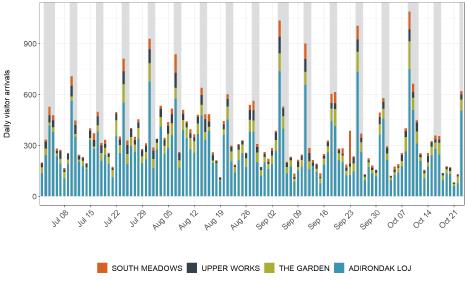 Data-Based Management Recommendations
Data-Based Management Recommendations
As a result of the data collection and analysis, Otak was able to make tailored management recommendations for this subarea of the High Peaks Wilderness Complex. These recommendations (found on page 42 of the report) identify important areas of future research as well as necessary landscape-scale planning efforts for the wilderness complex.
The report also provides support for the use of intergroup and visitor-crowding related indicators in the APA and DEC’s VUMWM, while recommending that parking-related indicators be incorporated into the guidance.
Other recommendations included, pulled verbatim from Section 4 of the report:
- “As the DEC-APA continue to develop and refine thresholds related to intergroup encounters, they could consider developing thresholds specific to different recreation zones or trail segments, such as a separate threshold for the Algonquin trail and the Van Hoevenberg trail examined as part of this study” (page 42)
- “This study recommends the design and administration of a visitor experience survey, and potential focus groups with managers and decision-makers, as part of a next phase of work to refine thresholds for intergroup encounter rates in the High Peaks Wilderness study area” (page 43)
- “A more appropriate basis for developing and refining thresholds with respect to crowding on Wilderness summits would be a visitor experience survey that presents a series of photo simulations of PAOT levels to provide a numeric basis to evaluating conditions of crowding” (page 44)
Closing
The Council’s report documents that high levels of foot trail traffic in parts of the High Peaks diminished the sense of solitude typically found in other more remote wilderness areas. The report also tracked when parking lots in the area overflowed during times of high foot traffic and found that people start arriving in popular areas at 4 a.m. or earlier. By understanding the disbursement and concentration of visitors in the front- and backcountry, land managers can better assess where and how many resources are needed to maintain natural resource health and the visitor experience.
Lastly, the rigor of this study also underscores that Otak, with its national and Adirondack experience, has demonstrated they are extremely qualified to carry out New York State’s first VUM planning process.




